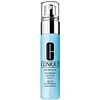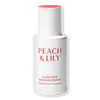What's inside
What's inside
 Key Ingredients
Key Ingredients

 Benefits
Benefits

 Concerns
Concerns

 Ingredients Side-by-side
Ingredients Side-by-side

Water
Skin ConditioningCyclopentasiloxane
EmollientDimethicone
EmollientPolysilicone-11
Acetyl Glucosamine
Skin ConditioningPEG-10 Dimethicone
Skin ConditioningVitis Vinifera Fruit Extract
Skin ConditioningMorus Nigra Root Extract
Skin ConditioningHordeum Vulgare Extract
EmollientCastanea Sativa Seed Extract
Skin ConditioningSalicylic Acid
MaskingPolygonum Cuspidatum Root Extract
AntioxidantCholesterol
EmollientSaccharomyces Lysate Extract
HumectantOryza Sativa Bran Extract
Skin ConditioningLactobionic Acid
BufferingScutellaria Baicalensis Root Extract
AstringentGlycine Soja Seed Extract
Skin ConditioningSalvia Sclarea Extract
AntiseborrhoeicTriticum Vulgare Germ Extract
Skin ConditioningSoy Amino Acids
Skin ConditioningDi-C12-18 Alkyl Dimonium Chloride
Skin ConditioningCaffeine
Skin ConditioningGlycerin
HumectantLaminaria Saccharina Extract
Skin ProtectingCreatine
Skin ConditioningAcetyl Carnitine Hcl
Skin ConditioningSqualane
EmollientGlycyrrhetinic Acid
Skin ConditioningAdenosine Phosphate
Skin ConditioningEthylhexylglycerin
Skin ConditioningPolysorbate 80
EmulsifyingSodium Hyaluronate
HumectantIsohexadecane
EmollientCaprylyl Glycol
EmollientButylene Glycol
HumectantCitric Acid
BufferingPolysorbate 20
EmulsifyingAcrylamide/Sodium Acryloyldimethyltaurate Copolymer
Emulsion StabilisingAmmonium Acryloyldimethyltaurate/Vp Copolymer
Yeast Extract
Skin ConditioningTocopheryl Acetate
AntioxidantHexylene Glycol
EmulsifyingPhytic Acid
Sodium Hydroxide
BufferingDisodium EDTA
BHT
AntioxidantPhenoxyethanol
PreservativeMica
Cosmetic ColorantCI 77891
Cosmetic ColorantWater, Cyclopentasiloxane, Dimethicone, Polysilicone-11, Acetyl Glucosamine, PEG-10 Dimethicone, Vitis Vinifera Fruit Extract, Morus Nigra Root Extract, Hordeum Vulgare Extract, Castanea Sativa Seed Extract, Salicylic Acid, Polygonum Cuspidatum Root Extract, Cholesterol, Saccharomyces Lysate Extract, Oryza Sativa Bran Extract, Lactobionic Acid, Scutellaria Baicalensis Root Extract, Glycine Soja Seed Extract, Salvia Sclarea Extract, Triticum Vulgare Germ Extract, Soy Amino Acids, Di-C12-18 Alkyl Dimonium Chloride, Caffeine, Glycerin, Laminaria Saccharina Extract, Creatine, Acetyl Carnitine Hcl, Squalane, Glycyrrhetinic Acid, Adenosine Phosphate, Ethylhexylglycerin, Polysorbate 80, Sodium Hyaluronate, Isohexadecane, Caprylyl Glycol, Butylene Glycol, Citric Acid, Polysorbate 20, Acrylamide/Sodium Acryloyldimethyltaurate Copolymer, Ammonium Acryloyldimethyltaurate/Vp Copolymer, Yeast Extract, Tocopheryl Acetate, Hexylene Glycol, Phytic Acid, Sodium Hydroxide, Disodium EDTA, BHT, Phenoxyethanol, Mica, CI 77891
Water
Skin ConditioningPropanediol
SolventButylene Glycol
HumectantNiacinamide
Smoothing1,2-Hexanediol
Skin ConditioningPrunus Persica Fruit Extract
AbrasiveDioscorea Japonica Root Extract
Skin ConditioningSodium Hyaluronate
HumectantAdenosine
Skin ConditioningHydrolyzed Sodium Hyaluronate
Skin ConditioningMadecassoside
AntioxidantHydrolyzed Hyaluronic Acid
HumectantSodium Acetylated Hyaluronate
HumectantAcetyl Octapeptide-3
HumectantEthylhexylglycerin
Skin ConditioningHydrolyzed Corn Starch
HumectantSodium Carbomer
Emulsion StabilisingBeta-Glucan
Skin ConditioningSaccharide Isomerate
HumectantPhytic Acid
Sucrose
HumectantAsiaticoside
AntioxidantCaprylyl Glycol
EmollientWater, Propanediol, Butylene Glycol, Niacinamide, 1,2-Hexanediol, Prunus Persica Fruit Extract, Dioscorea Japonica Root Extract, Sodium Hyaluronate, Adenosine, Hydrolyzed Sodium Hyaluronate, Madecassoside, Hydrolyzed Hyaluronic Acid, Sodium Acetylated Hyaluronate, Acetyl Octapeptide-3, Ethylhexylglycerin, Hydrolyzed Corn Starch, Sodium Carbomer, Beta-Glucan, Saccharide Isomerate, Phytic Acid, Sucrose, Asiaticoside, Caprylyl Glycol
 Reviews
Reviews

Ingredients Explained
These ingredients are found in both products.
Ingredients higher up in an ingredient list are typically present in a larger amount.
Butylene Glycol (or BG) is used within cosmetic products for a few different reasons:
Overall, Butylene Glycol is a safe and well-rounded ingredient that works well with other ingredients.
Though this ingredient works well with most skin types, some people with sensitive skin may experience a reaction such as allergic rashes, closed comedones, or itchiness.
Learn more about Butylene GlycolCaprylyl Glycol is a humectant and emollient, meaning it attracts and preserves moisture.
It is a common ingredient in many products, especially those designed to hydrate skin. The primary benefits are retaining moisture, skin softening, and promoting a healthy skin barrier.
Though Caprylyl Glycol is an alcohol derived from fatty acids, it is not the kind that can dry out skin.
This ingredient is also used as a preservative to extend the life of products. It has slight antimicrobial properties.
Learn more about Caprylyl GlycolEthylhexylglycerin (we can't pronounce this either) is commonly used as a preservative and skin softener. It is derived from glyceryl.
You might see Ethylhexylglycerin often paired with other preservatives such as phenoxyethanol. Ethylhexylglycerin has been found to increase the effectiveness of these other preservatives.
Phytic Acid is a gentle AHA and antioxidant. AHAs are chemical exfoliants that help remove dead skin cells. Phytic Acid has a slight and mild exfoliating effect.
The chemical makeup makes it classified as an AHA, much like lactic acid.
In some cases, it is a chelating agent. Chelating agents help prevent metals from binding to water, helping to stabilize the ingredients in a product.
An interesting fact about phytic acid is that it is considered an antinutrient. People do not have the enzyme needed to properly breakdown and digest phytic acid. When ingested, phytic acid binds to minerals and prevents them from being absorbed.
Read more about some other popular AHA's here:
Learn more about Phytic AcidSodium Hyaluronate is hyaluronic acid's salt form. It is commonly derived from the sodium salt of hyaluronic acid.
Like hyaluronic acid, it is great at holding water and acts as a humectant. This makes it a great skin hydrating ingredient.
Sodium Hyaluronate is naturally occurring in our bodies and is mostly found in eye fluid and joints.
These are some other common types of Hyaluronic Acid:
Learn more about Sodium HyaluronateWater. It's the most common cosmetic ingredient of all. You'll usually see it at the top of ingredient lists, meaning that it makes up the largest part of the product.
So why is it so popular? Water most often acts as a solvent - this means that it helps dissolve other ingredients into the formulation.
You'll also recognize water as that liquid we all need to stay alive. If you see this, drink a glass of water. Stay hydrated!
Learn more about Water